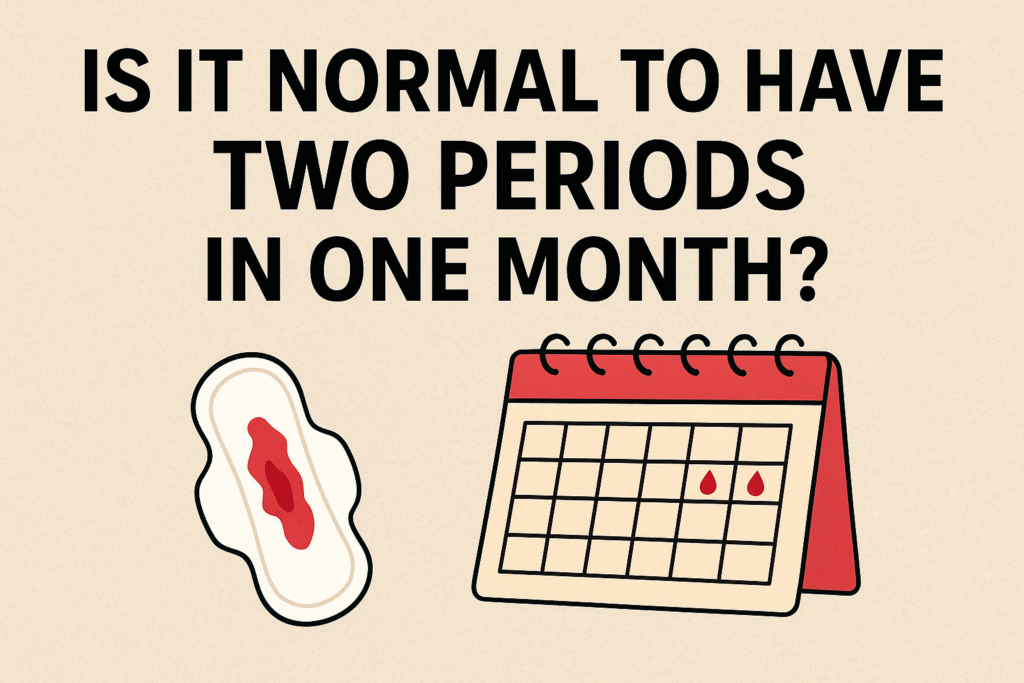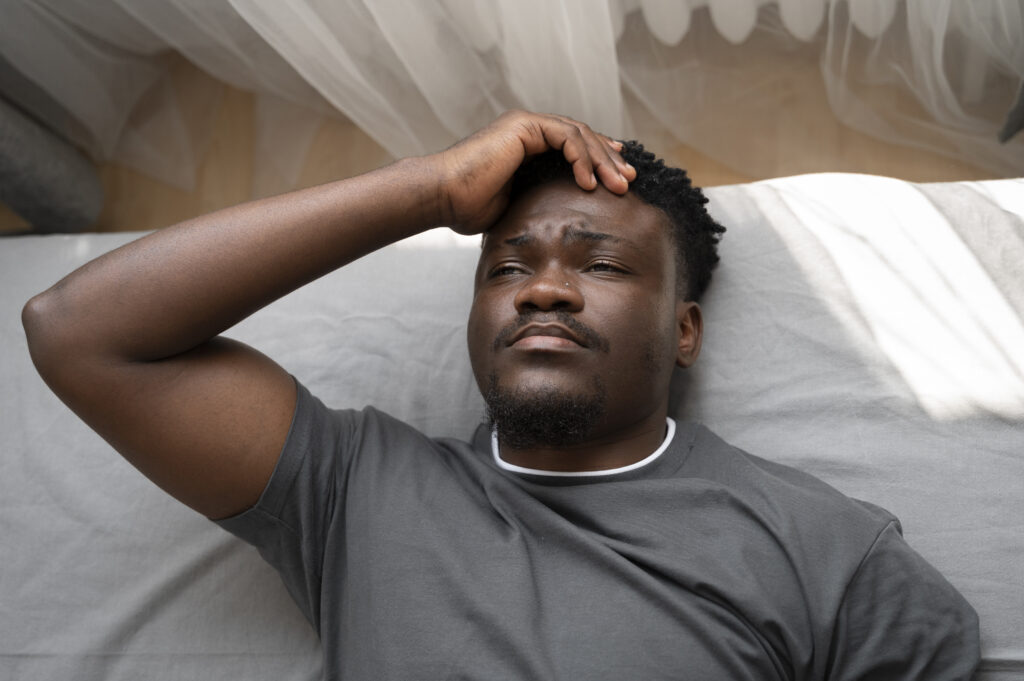
⚠️ Affiliate Disclaimer: This post may contain affiliate links, which means I may earn a small commission — at no extra cost to you — if you make a purchase through one of these links. I only recommend products or services I genuinely trust and believe can provide value. Thank you for supporting My Medical Muse!
Is It Normal to Have Two Periods in One Month 7 Key Facts You Must Know
Is It Normal to Have Two Periods in One Month? Causes, Concerns, and What to Do
Menstruation is often called a “monthly cycle,” but in reality, cycles don’t always follow a perfect 28 to 30 day pattern. Some women may experience bleeding more often, which can result in having two periods within the same month, while this can feel unusual or even alarming, it doesn’t always indicate a health problem.
Whether having two periods in a month is normal depends on several factors, including age, hormonal balance, underlying medical conditions, and lifestyle influences. In many cases, it may be a harmless variation but in others, it could signal something that requires medical attention.
In this article, we’ll explore:
- What it really means to have two periods in a single month
- Possible causes, from natural variations to medical conditions
- Warning signs that suggest you should see a doctor
- Practical tips for tracking and managing irregular cycles
- Answers to common questions about frequent periods
By the end, you’ll have a clearer understanding of when two periods in one month are just part of your body’s natural rhythm and when they might be a sign to seek professional care.
Understanding the Menstrual Cycle
To determine whether having two periods in one month is normal, it helps to first understand how the menstrual cycle works.
- Average cycle length: The typical menstrual cycle lasts about 28 days, but a healthy cycle can range anywhere from 21 to 35 days.
- Menstruation (bleeding phase): Period bleeding usually lasts between 3 and 7 days.
- Hormonal regulation: The cycle is carefully coordinated by hormones, including estrogen and progesterone (which build and shed the uterine lining), and luteinizing hormone (LH) and follicle-stimulating hormone (FSH), which control ovulation.
Because cycle length varies from person to person, a shorter cycle naturally leads to more frequent periods. For example, if your cycle is consistently 21 days:
- Your first period could start on March 1.
- Your next period might begin on March 22.
This results in two menstrual bleeds within the same calendar month without anything being medically wrong.
In short, experiencing two periods in one month doesn’t automatically signal a health issue. In many cases, it’s simply a reflection of your unique cycle length and hormonal rhythm.
Reasons You Might Have Two Periods in One Month
Experiencing two periods in a single month can have many explanations. Sometimes it reflects harmless variations in cycle length, while other times it may signal an underlying condition that requires medical attention. Below are the most common causes:
1. Short Menstrual Cycle (Polymenorrhea)
A normal menstrual cycle ranges from 21 to 35 days. If your cycle is consistently shorter than 21 days, you may menstruate more than once in a calendar month.
- This pattern, called polymenorrhea, is especially common among teenagers who are still developing regular ovulation patterns and women approaching menopause.
- On its own, a short cycle is not always concerning, but if bleeding is very heavy, painful, or irregular, it may be worth a medical evaluation.
2. Hormonal Imbalances
Your menstrual cycle depends on a delicate balance between estrogen and progesterone. When these hormones fluctuate, the uterine lining may shed unpredictably, leading to more frequent bleeding.
Common triggers of hormonal imbalance include:
- Stress (increases cortisol, which disrupts reproductive hormones)
- Sudden weight gain or loss
- Poor sleep patterns
- Thyroid disorders
- Polycystic ovary syndrome (PCOS)
If cycles suddenly become irregular after being stable, it’s a sign to consult a healthcare provider.
3. Ovulation Bleeding
Some women notice light spotting around ovulation (about two weeks after their period starts). This is caused by a brief drop in estrogen levels or the release of the egg from the ovary, because it occurs mid-cycle, it can be mistaken for a second, lighter period.
4. Birth Control and Medications
Changes in hormonal contraception often affect bleeding patterns.
- Starting or stopping birth control pills may trigger irregular bleeding.
- IUDs, implants, and emergency contraceptives sometimes cause spotting or breakthrough bleeding.
- Non-contraceptive medications such as blood thinners or hormone therapies can also influence the uterine lining.
While this is usually temporary, persistent or heavy bleeding should be checked by a doctor.
5. Uterine Fibroids and Polyps
Structural changes in the uterus may cause frequent or irregular bleeding.
- Fibroids are benign growths in the muscular wall of the uterus that may lead to heavy, prolonged, or more frequent periods.
- Polyps are small growths on the uterine or cervical lining that can cause spotting between periods.
Both conditions are treatable but require medical evaluation to rule out other causes.
6. Perimenopause
As women approach menopause (usually in their 40s), hormonal fluctuations can make cycles shorter, longer, or more unpredictable.
- Some women may notice bleeding twice in one month.
- Others may skip periods altogether.
While irregular cycles are common during this stage, it’s important to discuss abnormal or heavy bleeding with a healthcare provider to rule out other issues.
7. Pregnancy-Related Bleeding
Not all bleeding during pregnancy is normal menstruation. In fact, what may seem like a second period could be:
- Implantation bleeding: light spotting when the fertilized egg attaches to the uterus.
- Early miscarriage: which can appear similar to a heavy period.
- Ectopic pregnancy: a potentially serious condition where the embryo implants outside the uterus, often accompanied by pain and irregular bleeding.
If you suspect pregnancy and experience unexpected bleeding, seek immediate medical advice.
8. Infections
Reproductive tract infections can irritate the uterus and cause unexpected bleeding. These include:
- Sexually transmitted infections (STIs) like chlamydia or gonorrhea.
- Pelvic inflammatory disease (PID), an infection of the uterus, fallopian tubes, or ovaries.
Other signs may include pelvic pain, fever, or unusual vaginal discharge. Prompt treatment is essential.
9. Thyroid Disorders
The thyroid gland plays a major role in regulating hormones that influence menstruation.
- Hyperthyroidism (overactive thyroid) and hypothyroidism (underactive thyroid) can both disrupt menstrual cycles.
- A shorter cycle may lead to two periods in one month.
Other thyroid-related symptoms include weight changes, hair loss, fatigue, or heart palpitations.
10. Stress and Lifestyle Factors
Chronic stress, extreme exercise, or poor nutrition can interfere with hormone regulation.
- Elevated cortisol from stress can disrupt the balance of estrogen and progesterone.
- Over-exercise or rapid weight fluctuations may cause irregular cycles.
- Lack of sleep and poor diet further contribute to hormonal instability.
In these cases, lifestyle adjustments often help restore cycle regularity.
When Two Periods in a Month Are Normal
While having two periods in one month may sound unusual, there are circumstances where it is considered normal and not a cause for concern:
- Adolescence (Teenagers): In the first few years after menstruation begins, cycles are often irregular as the body adjusts to hormonal changes. It’s common for teens to experience shorter cycles, missed periods, or even two periods in a month.
- Perimenopause: Women in their late 30s or 40s approaching menopause often experience cycle changes. Hormone fluctuations during this stage can lead to shorter or irregular intervals between periods, sometimes resulting in two within a single month.
- Naturally Short Cycles: If your cycle is consistently around 21 days or less, two periods in one calendar month may simply be your body’s normal rhythm. This is not usually a problem unless bleeding is heavy or accompanied by pain.
- Birth Control Adjustments: Starting, stopping, or switching hormonal birth control can temporarily disrupt your cycle. Spotting, breakthrough bleeding, or shorter intervals between periods are common side effects during the first few months of adjustment.
In these cases, having two periods in a month is typically harmless. However, monitoring your cycle and noting any unusual changes is still important.
When to Be Concerned
Although two periods in a month are sometimes normal, there are situations where frequent bleeding signals a potential health issue. Seek medical attention if you notice:
- Very heavy bleeding: Needing to change pads or tampons every 1-2 hours, or bleeding that lasts longer than a week.
- Passing large clots: Clots larger than a quarter can indicate abnormal bleeding.
- Severe pelvic pain or cramping: Especially if the pain is new, worsening, or interfering with daily life.
- Sudden cycle changes: If your periods were regular and then became unpredictable or frequent without explanation.
- Bleeding after menopause: Any vaginal bleeding after menopause is abnormal and requires evaluation.
- Symptoms of anemia: Fatigue, dizziness, shortness of breath, or pale skin can suggest blood loss is affecting your overall health.
If you experience any of these warning signs, it’s best to schedule an appointment with a gynecologist. Early evaluation can identify whether the cause is benign (like fibroids or hormonal changes) or requires more urgent treatment.
Diagnosis: How Doctors Evaluate Irregular Bleeding
If you experience two periods in one month frequently, your doctor will conduct a thorough evaluation to determine the underlying cause. Diagnosis usually involves several steps:
- Medical History Review
Your doctor will ask about your menstrual patterns (cycle length, duration, flow), medical history, current medications, and any family history of gynecological disorders. This helps identify potential triggers such as birth control use, thyroid disease, or inherited conditions. - Pelvic Examination
A physical exam allows your doctor to check for abnormalities in the uterus, cervix, or ovaries. Conditions such as fibroids, ovarian cysts, or infections may be identified at this stage. - Blood Tests
Blood work can provide valuable information about your overall health and hormone balance. Tests may include:- Hormone levels (estrogen, progesterone, FSH, LH)
- Thyroid function tests to check for hypo or hyperthyroidism
- Iron levels and complete blood count (CBC) to assess for anemia
- Hormone levels (estrogen, progesterone, FSH, LH)
- Ultrasound Scan
A pelvic ultrasound uses sound waves to produce images of the uterus and ovaries. It helps detect fibroids, ovarian cysts, endometrial thickening, or other structural issues that could explain frequent bleeding. - Pap Smear or Endometrial Biopsy
If abnormal growths or unusual bleeding patterns are suspected, a Pap test or biopsy may be performed. These tests can detect precancerous or cancerous changes in the cervix or uterine lining.
By combining these diagnostic tools, your doctor can determine whether frequent bleeding is due to a benign cause, a hormonal imbalance, or a more serious condition.
Treatment Options
Once the cause of frequent periods is identified, treatment is tailored to address the root issue. Common treatment options include:
- Hormonal Therapy
Birth control pills, hormonal IUDs, or progesterone supplements can help regulate the cycle, reduce heavy bleeding, and correct hormone imbalances. - Thyroid Medication
If a thyroid disorder is found, appropriate medication can restore normal hormone function and improve menstrual regularity. - Surgical Procedures
For women with fibroids, polyps, or other structural abnormalities, surgical interventions such as hysteroscopic removal, myomectomy, or endometrial ablation may be recommended if symptoms are severe. - Iron Supplements
If heavy or frequent bleeding has caused anemia, iron supplementation can help restore healthy blood levels and relieve fatigue. - Lifestyle Modifications
In cases where stress, diet, or weight changes are contributing factors, doctors often recommend stress management, balanced nutrition, regular exercise, and stable sleep routines to help regulate cycles naturally.
Treatment plans are highly individualized, what works for one person may not be the best option for another. The goal is always to restore balance, reduce symptoms, and improve quality of life.
Tips for Managing Frequent Periods
While medical care is essential when frequent bleeding persists, there are also practical steps you can take to manage your cycles and protect your health:
- Track Your Cycle
Use a calendar or mobile app to record period start dates, flow, and symptoms. This makes it easier to identify patterns and provide accurate information to your doctor. - Prioritize an Iron-Rich Diet
Eating foods like spinach, beans, fortified cereals, poultry, and red meat can help prevent anemia caused by frequent blood loss. Pairing iron-rich foods with vitamin C (such as citrus fruits) improves absorption. - Stay Hydrated
Frequent bleeding can sometimes lead to dehydration and fatigue. Drinking enough water helps support energy levels and overall health. - Manage Stress
Chronic stress disrupts hormone balance. Techniques such as yoga, meditation, breathing exercises, or counseling can help regulate cycles by lowering cortisol levels. - Regular Checkups
Scheduling routine gynecological visits ensures that any cycle changes are monitored and addressed early. Preventive care is key to long-term reproductive health.
Common Myths About Having Two Periods in One Month
Because frequent periods can feel unusual or alarming, there are many misconceptions surrounding what it means. Let’s clear up some of the most common myths:
Myth 1: Two periods always mean pregnancy problems
- Not true. While certain pregnancy-related issues such as miscarriage or ectopic pregnancy can cause bleeding, there are many other harmless explanations, including short cycles, hormonal fluctuations, or adjustments to birth control. Experiencing two periods in a month does not automatically mean something is wrong with a pregnancy or that you are even pregnant.
Myth 2: It only happens to older women
- False. Irregular cycles can occur at any age. Teenagers often experience shorter or unpredictable cycles as their bodies adjust to new hormone patterns, and women nearing menopause may also notice cycle changes. Even women in their 20s and 30s can experience two periods in a month due to stress, lifestyle changes, or underlying conditions.
Myth 3: It’s always dangerous
- Not necessarily. In many cases, having two periods in one month is simply your body responding to temporary hormonal shifts, stress, or natural variations in cycle length. While frequent or heavy bleeding should always be evaluated, it does not always point to a serious illness.
Understanding the difference between myths and facts helps reduce unnecessary worry and encourages women to seek medical advice only when it is truly needed.
Preventing Irregular Periods
Not every case of irregular or frequent bleeding can be prevented, since some causes like puberty, perimenopause, or certain medical conditions are outside your control. However, adopting healthy habits can reduce risk factors and promote more regular cycles:
- Maintain a healthy weight: Being significantly underweight or overweight can disrupt hormone balance and menstrual regularity. Aim for balanced nutrition and regular exercise.
- Manage stress effectively: Chronic stress elevates cortisol, which interferes with reproductive hormones. Relaxation techniques such as yoga, meditation, journaling, or mindfulness can help.
- Avoid smoking and limit alcohol intake: Both can negatively affect hormone production and overall reproductive health.
- Prioritize sleep and rest: Consistent, restorative sleep supports hormone balance and immune function.
- Stay physically active but in moderation: Exercise helps regulate hormones, but over-exercising can sometimes shorten or disrupt cycles.
- Schedule regular gynecological checkups: Annual visits allow your doctor to monitor cycle changes, screen for underlying conditions, and provide personalized advice.
By combining lifestyle strategies with regular medical care, you can reduce the likelihood of irregular cycles and protect your long-term reproductive health.
Frequently Asked Questions (FAQs)
1. Can stress cause two periods in one month?
Yes. High stress increases cortisol, a hormone that disrupts the balance of estrogen and progesterone. This can lead to shorter cycles or breakthrough bleeding, making it seem like you’ve had two periods in one month.
2. Is it possible to get pregnant if I have two periods in one month?
Yes. Having two periods does not prevent ovulation. In fact, irregular cycles can make it harder to track your fertile window. If you are sexually active and not trying to conceive, reliable contraception is still necessary.
3. Should I see a doctor if it happens once?
Not necessarily. If you have two periods in one month on a single occasion and otherwise feel well, it may just be a temporary hormonal shift. However, if the pattern repeats, or if bleeding is heavy or painful, it’s wise to schedule a medical evaluation.
4. Can birth control cause two periods in one month?
Yes. Birth control methods particularly when you first start or switch pills, implants, or IUDs can cause irregular bleeding or spotting. This usually stabilizes within a few months, but persistent irregularities should be discussed with your healthcare provider.
5. Is having two periods in one month a sign of cancer?
Not always. While uterine or cervical cancers can cause abnormal bleeding, this is relatively rare compared to more common causes such as fibroids, hormonal imbalances, or thyroid issues. Still, any unexplained or persistent bleeding should be evaluated by a doctor to rule out serious conditions.
Conclusion
Having two periods in one month can sometimes be completely normal, especially if you naturally have a shorter cycle, are in your teenage years, or are approaching menopause. In these cases, the change is usually a natural part of hormonal development or transition.
However, frequent bleeding can also signal underlying issues such as hormonal imbalance, fibroids, thyroid disorders, infections, or even pregnancy-related complications. Because menstrual health reflects overall reproductive well-being, it’s important to pay attention to your body’s signals.
The best approach is to:
- Track your cycles consistently to spot patterns.
- Note any unusual symptoms, such as heavy bleeding, severe pain, or fatigue.
- Seek medical guidance if something feels unusual or persists.
Remember, your period is not just a monthly event, it’s a vital health indicator. Taking irregular bleeding seriously helps protect both your reproductive health and your overall wellness.
👩⚕️ Need Personalized Health Advice?
Get expert guidance tailored to your unique health concerns through MuseCare Consult. Our licensed doctors are here to help you understand your symptoms, medications, and lab results—confidentially and affordably.
👉 Book a MuseCare Consult NowRelated Blog Post You Might Like:
- Why Do I Get Cramps but No Period? 10 Causes and Effective Solutions
- 10 Powerful Ways to Tell PMS Apart from Early Pregnancy Symptoms
- Brown Discharge Before Period: 7 Alarming Causes & When to Worry
- 10 Powerful Reasons Why Your Period Is Late but Pregnancy Test Is Negative
- 10 Essential Facts Every Woman Must Know About Ovarian Cysts
- 7 Powerful Signs Severe Cramps in Teens Could Be Endometriosis


